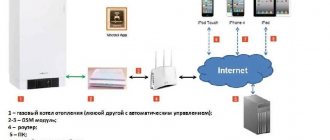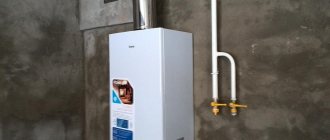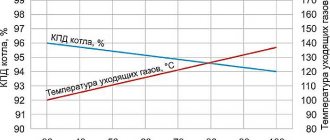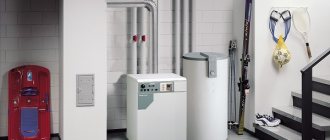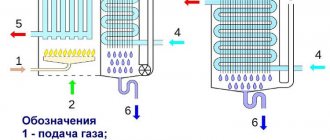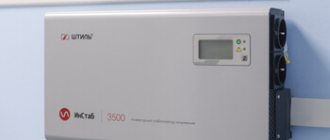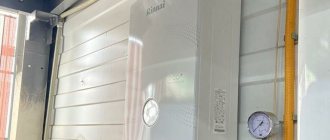These are usually gas boilers running on main gas, which are connected in a cascade in order to heat rooms from 500 sq.m. total area. It is quite rare that diesel or solid fuel boilers are combined together for main heating.
We are talking specifically about the main heat generators and heating of residential premises. Because cascade and modular boiler houses for heating large industrial premises can include “batteries” of coal or fuel oil boilers in quantities of up to one dozen.
So, as mentioned above, the main boilers are connected in a cascade, when a second identical boiler or slightly less powerful one complements the first heat generator.
Usually, during the off-season and mild frosts, the first boiler in the cascade operates. In cold weather or when it is necessary to quickly reheat the premises, a second boiler in the cascade is connected to it to help.
In a cascade, the main boilers are connected in series so that the second boiler reheats the water heated by the first heat generator. At the same time, of course, in this combination it is possible to isolate each boiler and a bypass, which allows water to bypass the isolated boiler.
In case of problems, any of the heat generators can be turned off and repaired, while the second boiler will regularly heat water in the heating system.
There is no special alternative to this system. As practice shows, it is better and more reliable to have 2 boilers with a capacity of 40 kW each than one boiler with a capacity of 80 kW. This allows you to repair each individual boiler without stopping the heating system.
It also allows each of the boilers to operate at its full power if necessary. While 1 high-power boiler would operate only at half power with low efficiency and increased clocking.
Hydraulic arrow in a parallel connection system
A hydraulic arrow is a device that provides hydraulic isolation of flows supplied to individual circuits of the heating system.
It plays the role of a buffer tank, receiving the flow of coolant heated by the boilers and distributing it to consumers in a branched system. Often the volume of coolant required for them differs, the speed of movement of the heated water and its pressure differ. And in the situation under consideration, the movement of heated water from each of the boilers also stimulates its own circulation pump.
When the powerful pump is turned on, the coolant is unevenly distributed throughout the circuits. So, the task of the hydraulic gun is to equalize this pressure. Due to the fact that there is virtually no hydraulic resistance inside it, it will freely receive and distribute coolant flows from both boilers.
Let’s figure out whether it is really necessary in a parallel system for connecting 2 boilers, especially since if you buy and install a hydraulic separator with the help of a specialist, and not with your own hands, the total amount will be unpleasantly surprising.
The device is a piece of pipe with pipes, hollow or with filter meshes to remove bubbles and filter out incoming contaminants. It can be placed in any position, but more often vertically, with an air vent on top and a shut-off valve on the bottom for cleaning. A hydraulic arrow is installed between the boiler and heating circuits
In the classic connection scheme, a hydraulic separator is usually not required, since the conflict of 2-3 pumps can be equalized without this device. Accordingly, if you have 2 boilers that are used exclusively as a backup and there are no more than 3-4 pumps in the system, there is no particular need for it.
But if there are more forced circulation circuits or heating boilers operate simultaneously at full power, it is best to install this device. Again, it is unknown whether you will use the second boiler permanently or only in backup mode, so it is better to be safe.
Advantages of a two-boiler system
The main positive aspect of installing two boilers in one heating system is the continuous maintenance of heat in the room. A gas boiler is convenient because it does not need to be constantly maintained. But in case of an emergency shutdown or in order to save money, a wood-burning boiler will become an indispensable heating addition.
The heating system of two boilers can significantly increase the level of comfort. The advantages of a double thermal device include:
- selection of the main fuel type;
- the ability to control the entire heating system;
- increasing the operating time of equipment.
Connecting two boilers into one heating system is the best solution for heating buildings of any size. This solution will allow you to continuously maintain heat in the house for many years.
Multi-fuel boilers instead of two boilers
For small heat supply facilities, it is possible to install boilers whose design allows for the simultaneous combustion of several types of fuel.
The best pairs have proven themselves:
- solid fuel - electricity;
- main gas - liquefied gas;
- main gas - fuel oil;
- liquid fuel - electricity;
- liquefied gas - electricity;
The first pair is the most common and is implemented in many domestic solid fuel boilers, when heating elements with a load of at least 50% of the rated power are installed in the heating circuit.
Thus, having decided to equip a boiler room with two boilers capable of working together, the user definitely wins by receiving a more modern energy-efficient combined heat supply scheme.
With the correct selection of equipment, you can achieve not only the minimum cost of thermal energy, but also increase the level of automation, reliability and safety of the heating source.
The feasibility of using automatic and manual switching between two boilers
Let's consider the following five options with various units in conjunction with an electric boiler, which is in reserve and must turn on at the right time:
- Gas + Electric
- Firewood + Electric
- Liquefied gas + Electro
- Solar + Electro
- Pellet (granular) + Electro
Pellet and electric boiler
The combination of connecting two boilers - a pellet and an electric boiler - is best suited for automatic switching on and manual switching is also allowed.
A pellet boiler may stop because it has run out of fuel pellets. It got dirty and wasn't cleaned. The electric one must be ready to turn on to replace the stopped boiler. This is only possible with automatic connection. Manual connection in this option is only suitable when you permanently live in a house where such a heating system is installed.
Diesel boilers fuel and electricity
If you live in a house with such a system for connecting two heating boilers, a manual connection is quite suitable for you. The electric boiler will operate as an emergency boiler in case the boilers fail for some reason. They didn’t just stop, they broke down and require repairs. Automatic switching is also possible as a function of time. An electric boiler can operate in tandem with liquefied gas and a solar boiler at a night rate. Due to the fact that the night tariff is cheaper per 1 kW/hour than 1 liter of diesel fuel.
Combination of electric boiler and wood boiler
This combination of connecting two boilers is more suitable for automatic connection and less suitable for manual connection. A wood boiler is used as the main one. It heats the room during the day, and turns on the electricity to add heat at night. Or if you are not living in the house for a long time, an electric boiler maintains the temperature so as not to freeze the house. Manual operation is also possible to save electricity. The electric boiler will turn on manually when you leave and turn off when you return and start heating the house using a wood-fired boiler.
Combination of gas and electric boilers
In this combination of connecting two boilers, the electric boiler can act as both a backup and a main one. In this situation, a manual connection scheme is more suitable compared to an automatic one. The gas boiler is a proven and reliable unit that can operate for a long time without breakdowns. At the same time, connecting an electric boiler to the system for backup in automatic mode is impractical. If the gas boiler fails, you can always manually turn on the second unit.
Types of electric boilers
When choosing an electric boiler for installation in addition to a solid fuel one, it is enough to quickly familiarize yourself with the basics of heating water using electric current, so as not to get caught in the network of marketers. Electric boilers operate with an efficiency of about 95%. You should not use your heating system to check the veracity of the manufacturer’s assurances about the incomparably high efficiency of their devices - this may cost extra money, and it will not pay off soon. There are three main types of boilers:
Heating in them is carried out by an electric heating element (heating element), which is immersed directly in the coolant. Both water and antifreeze can circulate in the circuit of such a boiler. It is unpretentious in operation, but periodically requires replacement of the heating element due to the formation of scale, which reduces heat transfer.
The coolant in them is water. Heating occurs due to the energy released when electric current flows through the coolant in the boiler between the electrodes that are located inside. Can work without an electric pump in the circuit. Provides smooth heating of water in the system. Over time, as a result of electrolytic reactions, the electrodes dissolve and require replacement.
They heat up any type of coolant by vibrations caused by an induction coil. The temperature from the heating element is evenly distributed over the surface of the flow-through container, which almost completely eliminates the possibility of scale formation. To effectively use the boiler, high-quality automatic control is required.
Due to their high price, induction boilers are inferior to heating elements and electrode boilers. Given the auxiliary function of an electric boiler, the issue of return on investment in advanced technology fades into the background. The main selection criteria remain: power, quality of materials used in the device, build quality and equipment.
Solid fuel boiler connection diagram
The most effective connection diagram for solid fuel (SFC) and electric (EC) boilers is parallel. The supply to the heating system of both boilers is carried out at one point, as well as the return. This scheme eliminates inconsistency in pump operation and heat loss in the TTK heat exchanger when the EC is operating. The operating algorithm of such a system can be described as follows:
- a working TTK maintains a comfortable air temperature in the room;
- the fuel has burned out, the coolant cools down, and when the set minimum temperature is reached, the thermostat turns off the pump;
- the air temperature in the room drops below the comfortable one (set by the user) and the EC turns on.
For proper operation of the system, it is necessary to take into account some features of connecting devices and fittings. The productivity of the T.T.K pump must be greater than that of the EK pump so that the simultaneous operation of boilers does not affect the speed of coolant movement through the TTC heat exchanger. In the heating system, there must be a check valve in the supply of each boiler to prevent backflow.
To control the operation of the TTK pump, a thermostat is used that measures the temperature of the coolant in the supply to the check valve. A remote air temperature sensor that controls the activation of the EC must be placed in one of the heated rooms.
To control the EC, they are also used, which allow, using mobile communications, to set the temperature mode for turning the boiler on or off. This method will allow you to program the boiler to turn on only at night to save energy and maximize the benefits of multi-zone tariffing. You can also set the required air temperature, for example, a few hours before arriving at the cottage.
With the right choice of equipment and fittings for the boiler room, the power of two boilers connected according to the proposed scheme will ensure an uninterrupted supply of heat, creating coziness and comfort in the house. And for owners of country houses - additional convenience of controlling the heating system.
Connecting solid fuel into one system solves the fuel issue for the owner. A single-fuel boiler is inconvenient because if you do not replenish supplies in a timely manner, you may be left without. Combination boilers are expensive, and if such a unit breaks down seriously, all the heating options provided in it will become unfeasible.
Two-pipe connection diagram with boiler
Connecting a double-circuit gas boiler.
To connect the heating system, a two-pipe circuit can be used. The coolant here will move up along one separate line, and then return back to the boiler along a completely different one. In such a system, as a rule, forced circulation of the coolant is used, i.e., the installation of a circulation pump is required. But the system warms up much faster, and it loses less heat during transportation to the radiators.
This reduction in heat loss is due to the fact that a special heat regulator can be installed for each radiator, without causing any damage to the other components of the entire system. The installation of this system with a boiler is very different from a single-pipe system, for which installing regulators is simply impossible. An example of such a boiler connection diagram is shown in Fig. 3. For installation, according to this boiler diagram, you can use different types of pipes, radiators, everything warms up evenly and correctly.
Direct connection diagram for a gas double-circuit boiler.
Connecting the system to the boiler is carried out in several ways, one of them involves supplying coolant to and from the radiator from one side of the equipment. On the other side, regular plugs are installed, the return pipe goes from below, while the coolant flows from above. But if the radiator has more than 15 sections, then such a scheme is not used due to large heat losses. In this case, a connection diagram is used when the coolant is supplied from below to different sides of the equipment. This method is effective when all the pipes of the heating system are laid under the floor, the outlets are organized only in the places where the heating radiators are installed. But there are also some disadvantages: the coolant may not completely warm up the radiator from bottom to top, so cast iron radiators are not used; preference is given to panel radiators, which are heated best.
When the lower connection diagram is performed, it is also necessary to provide for an emergency shutdown from the coolant supply. This allows you to avoid leaks if the entire heating system malfunctions. If all conditions are met correctly, then heat loss will be minimized, it will be approximately equal to 2%.
Connecting a heating boiler and completing the entire wiring of the house system is an important and complex process. It is necessary to strictly follow all standards and recommendations, having previously calculated which elements should be included in the connection diagram and what type of heating wiring to choose.
Installation of gas equipment
When a double-circuit heating system is installed, the diagram must be followed exactly - only in this case will the equipment work correctly and efficiently.
The body of the heating unit should not be adjacent to the wall, nor should it be installed in niches.
- electrical;
- hydraulic;
- gas
The outer pipes are necessary to connect the equipment to the heating system. On the left, hot water flows into the batteries, and on the right, cooled water returns for heating. Thus, connecting a double-circuit heating boiler is quite simple; you just need to follow the recommendations of specialists.
A coarse filter must be installed on the return pipe connection - this is necessary in order to protect the boiler from debris and rust that will accumulate in the pipes. If it is not installed, the service life of the equipment will be significantly reduced. Screw the filter to the pipe in the direction of the arrow to the boiler.
The water supply and return pipes are equipped with taps, with the help of which, in the event of a heating unit breakdown, the water can be turned off. If this is not done, then before starting the repair you will have to drain the coolant from the heating system, and this will take time. The water supply circuit is connected in approximately the same way; a filter is installed on the cold water supply to prevent the device from becoming clogged with debris. To cut off the pipeline circuit, it is also necessary to install taps.
When installing a double-circuit heating boiler, several conditions must be observed. Before starting the system, you need to make sure that the cold and hot water taps have not been mixed up. A mistake in this can lead to dire consequences - even an explosion of the gas boiler, so you should not take connecting the equipment lightly.
Next, the expansion tank is installed. It is needed to compensate for the expansion of the heating system due to increased pressure. The volume of the tank should be approximately equal to 10% of the amount of coolant in the entire system. Most often, the tank is installed between the boiler and the circulation pump, but it can also be placed in another place where it will not interfere. It will also come in handy if the pressure in a double-circuit boiler drops.
Bath heating
Heating a bathhouse from the main boiler of the house has its own characteristics. For example, a bathhouse is operated at high temperatures, which are completely useless in a residential building. Therefore, in order to protect against failures in the boiler automation, a separate circuit is needed, even if the bathhouse is in contact with the house. This is necessary, because when the stove in the bathhouse is ignited, the heating of the bathhouse will practically stop giving off heat, which will sharply increase the temperature of the return water, which can lead to the cooling of the house. In addition, heating the bathhouse is also necessary in the warm season, when the heating in the house is turned off. And turning on the single-circuit system will begin to heat the house, which is completely out of place in thirty-degree heat. Only very qualified designers, whom we will be happy to provide to you, can take into account all these nuances when creating common heating for two buildings.
How to connect two double-circuit boilers to produce hot water?
Well, there is another option where two boilers in one system operate on hot water supply. In such a scheme, it is best to have one boiler heat water for one group of consumers, for example, for a shower; the second one is for everyone else:
Then the person taking a shower will be spared the troubles experienced when there is only one wall-mounted boiler: when opening and closing other hot water taps at the same time (for example, in the kitchen), there will be no temperature fluctuations in the shower room.
Note in the diagram that there is a ball valve between the hot circuits. This is in case of repair/prevention/replacement of one of the boilers, when the remaining one will heat water for all consumers
Only after the repair you need to remember to open the tap.
Well, I think I said everything about two boilers in one system.
Two boilers in one heating system: diagrams
Boilers can be single- or double-circuit. Regardless of the type, two boilers in one system are connected in parallel.
Obviously, single-circuit boilers are installed when they think of heating water with an indirect heating boiler...
How to connect two wall-mounted gas boilers to one radiator circuit?
So, the diagram shows two boilers in one system with one branch of radiators:
The main thing is to pay attention to the piping of the boilers. And radiator wiring can be different
How to connect two wall-mounted gas boilers to several circuits?
For several circuits, we connect two boilers in one system like this:
We connect the boilers with radiator branches through a hydraulic valve and a manifold. The manifold can be assembled from individual parts - tees, adapters, couplings, bends, nipples... and connected to a separately purchased hydraulic arrow. To simplify and speed up assembly, you can purchase something like this:
And don't worry.
Please note: in the boiler piping, compared to the first diagram, an addition has appeared - check valves for each boiler. Also: instead of radiators, you can connect branches of a water-heated floor to the collector outputs, as here, or an indirect heating boiler, and everything will work
Also: instead of radiators, you can connect branches of a water-heated floor to the collector outputs, as here, or an indirect heating boiler, and everything will work.
Since the system is large, the volume of expansion tanks in the boilers may not be enough; this needs to be checked and, if necessary, connected to the tanks externally. The volume of the tank of EACH boiler must be at least 15% of the volume of the entire system for water and 20% for anti-freeze. This is in case one of the boilers has to be turned off.
Parallel and series connection of boilers
When planning a heating system of two or three boilers, it is important to take into account the position of the main and connecting elements. And the point is not only in ease of operation and space saving, but also in the ability to carry out repairs of local areas, preventive maintenance and obtaining technically safe operation of the heating system. The choice of parallel or serial connection, the creation of technical diagrams allow you to carefully consider all the nuances of installing equipment and additional elements, the length and number of pipes, their laying and places for wall grooves
The choice of parallel or serial connection, the creation of technical diagrams allow you to carefully consider all the nuances of installing equipment and additional elements, the length and number of pipes, their laying and places for wall grooves.
Parallel connection
Parallel connection is used to connect gas and solid fuel boilers with a volume of more than 50 liters. This choice is justified, first of all, by saving coolant and reducing the load on the system.
Advice: before calculating the savings, you need to take into account the high cost of such systems and the installation, in combination with an electric boiler, of additional equipment on the circuit: shut-off valves, expansion tank - safety group.
Note that a parallel type system can operate in two modes: manual and automatic, in contrast to a sequential one. In order for the system to operate only in manual mode, it is necessary to install shut-off valves/ball valves or a mortise By-Pass system.
To organize automatic operation of an electric boiler with a gas or solid fuel, you will need to install a servo drive and an additional thermostat, a three-way zone valve to be able to switch the heating circuit from one boiler to another. This connection option is appropriate when the total displacement of the system coolant is per 1 kW of boiler power.
Serial connection
The feasibility of a series connection is justified if an expansion tank and a safety group built into the gas boiler are used. In this situation, you can connect the heating system with the least difficulty.
In order to save on components and increase functionality when connecting an electronic boiler paired with a solid fuel or gas boiler, it is necessary to take into account the volume of the tank. Connection recommended for sizes up to 50 liters.
An electric boiler can be connected before or after a gas boiler, depending on the convenience and physical possibility of connecting the system. It is recommended to make a connection taking into account the fact that the circulation pump will be located on the “return” of both one and the second boiler. If a circulation pump is used in a gas boiler, then the best option would be to install an electric boiler first, and then a gas one.
Important: the use of a safety group and an expansion tank when connecting the heating system of a gas and electric boiler is a key point when connecting to an existing circuit. https://www.youtube.com/embed/txgDeelw8WQ. https://www.youtube.com/embed/txgDeelw8WQ
To summarize, we can say that each of the schemes has the right to exist and has proven its effectiveness. And yet, what should you choose and how to correctly organize the connection of boilers in pairs: in series or in parallel? The answer will vary depending on your individual requirements:
- physical capabilities of the room for installing two boilers;
- well-thought-out ventilation and sewage system;
- ratio of thermal and energy parameters;
- choice of fuel type;
- the ability to control and prevent the heating system;
- financial component when purchasing boilers and additional elements.
Basic principles for connecting a solid fuel unit
When considering how to properly connect a solid fuel boiler, you need to pay attention to the basic piping elements that ensure the safe operation of the heat generator. We are talking about the safety group and the mixing unit
The safety group, which includes a pressure gauge, as well as a safety valve and an air vent, mounted on one manifold, is installed directly on the outlet pipe of the boiler unit. The pressure gauge helps monitor the pressure in the system, the air vent serves to remove air pockets, and the safety valve releases excess steam-water mixture when the pressure exceeds the specified parameters.
Important! It is prohibited to install a circulation pump or shut-off valves between the pipe and the safety group. A mixing unit based on a three-way valve with a thermal head is installed together with a bypass (jumper) connecting the supply and return pipes, thereby forming a small circulation circuit
A mixing unit based on a three-way valve with a thermal head is installed together with a bypass (jumper) connecting the supply and return pipes, thereby forming a small circulation circuit.
The system that protects the boiler from condensation and temperature shock operates according to the following scheme
:
- While the fuel flares up, the valve blocks the flow of cooled coolant from the large heating circuit. As a result, the circulation pump circulates a limited volume of coolant in a small circle.
- A sensor is installed on the return pipe, connected to the thermal head of a three-way valve. When the coolant in the return pipeline heats up to 50-55 degrees, the thermal head is activated and presses on the valve stem.
- The valve smoothly opens slightly and the cooled coolant begins to gradually flow into the boiler jacket, mixing with the heated coolant from the bypass.
- When all radiators warm up and the return temperature rises to values safe for the boiler, the three-way valve closes the bypass, completely opening the passage of coolant flow through the return pipeline.
The basic diagram for connecting a solid fuel boiler to the heating system is as simple and reliable as possible; you can install the piping yourself.
It is important to know how to connect a solid fuel boiler using polymer pipes to avoid common problems:
- It is unsafe to use polymer pipes for piping a boiler - they may not withstand an emergency increase in temperature and pressure. Therefore, it is recommended to make the piping with steel or copper, and connect the polymer pipes to the manifold that distributes the coolant through the heating circuits. As a last resort, a metal pipe is installed only between the boiler supply pipe and the safety group.
- The use of a thick-walled polypropylene pipe for the return pipeline in the area between the three-way valve and the boiler pipe leads to the fact that the surface-mounted temperature sensor responds to the heating of the coolant with a noticeable delay. It is better to install a metal pipe.
Connecting a solid fuel installation with a hydraulic boom
The pump for a heating system with forced supply of coolant is installed on the return pipe between the three-way valve and the boiler. This arrangement allows it to circulate water or antifreeze in a small circle. It is impossible to install the circulation pump on the supply pipe, since the device is not designed to work with a steam-water mixture that is formed when the coolant overheats. Stopping the pump will speed up or provoke an explosion of the heating boiler, since cooled coolant will no longer flow into it.
How to reduce the cost of harness
The basic connection diagram for a solid fuel boiler involves the use of a three-way mixing valve equipped with a thermal head and an overhead sensor. This equipment is quite expensive, and it can be replaced with a cheaper option - a three-way valve with a built-in thermostatic element. This device has a fixed setting - the valve is activated when the ambient temperature reaches 55 or 60 degrees (depending on the model).
Installing a valve that maintains a fixed temperature reduces the financial costs of installing protection for a solid fuel unit from condensation and thermal extremes. The ability to flexibly control the temperature of the coolant is lost; deviations from the set value can reach 1-2 degrees, but this is not critical.
Requirements for the room and air exchange
To ensure normal air exchange in the room when the boiler is operating, it will be necessary to equip an effective natural ventilation system that provides 3 times the hourly air exchange of the room.
When calculating the supply ventilation, the volume of air required for the combustion process is added to this indicator, the value of which is taken from the passport data.
It is important to take care of ventilation in the room with the boiler
Basic requirements for the room where the boiler will be installed:
- The smallest room height is 2.0 m, cubic capacity is 7.5 m3. In the case where two or more boilers are installed, the dimensions change to 2.5 m and 13.5 m3, respectively.
- It is not allowed to install heaters in basements, bathrooms, bathrooms, and corridors, as well as in rooms without windows.
- The walls of the boiler room must be protected with fire-resistant materials or special heat-resistant panels.
- Glazing is carried out according to the ratio per 10 m3 of room - 0.3 m2 of windows.
- The room is equipped with a protective grounding circuit.
- The cross-section of the chimney must correspond to the power of the boiler unit, and the diameter must correspond to the smoke pipe at the outlet of the boiler.
- To service the unit there must be free passages: at the front of the boiler - from 1.25 m, on the sides - from 0.7 m.
- When placing the gas duct, maintain a maximum distance from the vertical flue to the boiler - no more than 3.0 m.
Rules for installation on a wall or floor
The gas unit must be placed inside a separate room. which meets the following requirements:
- There is a window that can be opened at any time.
- Availability of functioning ventilation.
- Availability of gas and water pipes.
- The presence of an outlet to ensure the operation of the circulation pump and electronics. Of course, it should be the end of a separate branch that extends from the electrical panel. This cable must be connected to a separate circuit breaker. In addition, grounding is mandatory.
There are also requirements regarding the correct placement of the boiler in the house. They are:
- The distance between the main element of the heating system and other gas appliances must exceed 20 cm.
- There should be no window nearby.
- The distance between the boiler and the socket should be at least 0.5 m (at least, such recommendations are given by manufacturers). In general, the further the outlet is from the boiler, the better. It is worth adding that some models have a power cable without a plug. This means that you need to connect the wire yourself directly to the circuit breaker located in the electrical panel.
- The space between the side walls of the boiler and adjacent walls or objects must be greater than 15 cm.
- The wall on which or near which the boiler is installed must be strong and covered with non-flammable substances. If the wall is such that it can catch fire, it should be covered with at least 3 mm of non-combustible material. This is often noted in various videos.
Installation of a heating system with a heat accumulator
The use of such an element in a scheme with two boilers in one heating system has several features depending on the installed units:
- The heat accumulator, gas boiler and heating devices form a single closed system.
- Solid fuel boilers operating on wood, pellets or coal heat water, the thermal energy is transferred to a heat accumulator. This, in turn, heats the coolant circulating through a closed heating circuit.
To independently create a heating scheme with two boilers, you must purchase the following:
- Boiler.
- Thermal accumulator.
- Expansion tank of appropriate volume.
- Hose for additional coolant removal.
- There are 13 shut-off valves.
- Pump for forced circulation of coolant in the amount of 2 pieces.
- Three-way valve.
- Water filter.
- Steel or polypropylene pipes.
Such a scheme is characterized by operation in several modes:
- Transfer of thermal energy from a solid fuel boiler through a heat accumulator.
- Heating water with a solid fuel boiler without using this device.
- Receiving heat from a gas boiler connected to a gas cylinder.
- Connecting two boilers at the same time.
If the house has mains gas
Heating with natural gas is considered the cheapest and has a high level of automation. If the house is connected to the main line, it is obvious that such a boiler should be made the main one. Let's consider options for backup heat sources:
- Electricity.
Pairs perfectly with all types of gas appliances. The source can turn on when the coolant temperature drops or on command from the room thermostat. Electric heating has two disadvantages: limitations on allocated power and price. - Diesel fuel.
In terms of automation level, diesel burners do not differ from electric heating elements, but their operation requires a complex fuel storage and supply system. It is advisable to use this type of heating equipment in large commercial or industrial boiler houses, and not in everyday life. - Pellets.
A boiler with a pellet burner can easily solve the problem of backup heating. Starting in automatic mode is possible if it has an electric ignition heating element (candle). Otherwise you will have to do this manually. A pellet bunker requires additional space. - Coal.
A solid fuel boiler “in reserve” is an attractive solution at a price, but difficult to implement. Ignition and reloading can only be done manually. If a double-circuit wall-mounted boiler is used as the main heating, then it is almost impossible to integrate a coal boiler into the system.Pay attention to the design of the first device: it has a membrane expansion tank. This means that the heating system must be closed. Solid fuel boilers are used primarily in open heating systems. During coal combustion, the temperature in the system rises to high values, and the coolant increases in volume. If the system is closed, the pressure will rupture the heat exchanger, pipes or expansion tank membrane. Of course, you can install a relief valve, but then a lot of coolant will be lost. One solution for closed systems is the installation of an additional expansion tank, which will require increasing the area of the boiler room.
Connecting a floor-standing gas boiler will be easier. Most of them can run on open systems. Please note that these two boilers take air for combustion of fuel from the boiler room. If a mode of simultaneous operation of devices is provided, then the volume of the room and the productivity of the supply ventilation must correspond to their total power.
Another difficulty is the volume of the heating system. For normal operation of a solid fuel boiler, you need several times more coolant than a gas boiler. The problem can be solved by installing a heat accumulator.
- Natural gas.
There are heating systems with two or more boilers that run on natural gas. This solution is suitable for large commercial facilities where the volume of heat consumption varies over a wide range. Some manufacturers of such equipment make modular boiler rooms for several apartment buildings. If necessary, the modules are sequentially turned on or off in automatic mode.
Installation of a heating boiler in the attic
- Is it even possible to install heating boilers in the attic and second floor of the house? According to experts, this is not the best option, but in extreme cases, if there is no other way out, you can go for it, observing certain conditions;
- Which boiler can be installed above the first floor of the house? With a closed combustion chamber! It is much safer than the traditional one, although it costs half as much. Condensing boilers are suitable, in which the combustion chamber is always closed. In this case, there will be no risk of carbon monoxide poisoning, and the room will not cool down while the boiler is operating;
- It’s clear about the closed combustion chamber, but still, which boiler is ideal for installation in the attic? Wall-mounted gas, power up to 30 kW. Such boilers are compact, do not take up little space, and do not require a separate room. The indicated power will be quite enough to provide heat in a cottage designed for one family, that is, a relatively small one. The main thing is that the wall can support the weight of the boiler. However, we can solve this issue even in frame buildings;
- And if the boiler runs on solid or liquid fuel, not gas, can it be installed in the attic? Theoretically, yes. However, think about how you will service a solid fuel boiler on the top floor? You will have to constantly carry briquettes, coal and firewood up the stairs. And solid fuel boilers weigh a lot; the ceilings will need to be strengthened. Liquid fuel boilers are noisy and emit an unpleasant odor, so they are absolutely not suitable for installation on upper floors;
- What should the chimney be like if the boiler is installed in the attic or second floor? This is where problems can arise. In general, the height of the chimney for a gas heating boiler should be at least four meters. Imagine if such a pipe rises above your roof. This can ruin the appearance of the house. You can get rid of the need to build such a high chimney if you choose a boiler with a closed combustion chamber that has a coaxial pipe. For boilers with a power of up to 30 kW, which we recommend for installation in attics and second floors, the chimney can be routed directly through the outer wall. In this case, the pipe outlet should be located at a height of 2.5 meters from the ground, but in the case of an attic this is not a problem. The nearest window from the chimney going through the wall should be at least half a meter;
- What should the heating system be like if the boiler is installed above the first floor? Closed! This is a must. With an open heating system, when fluid circulation in the system occurs naturally, all heating devices are located above the boiler itself. In the case of installation in the attic or second floor, this condition for normal operation of the heating system cannot be maintained. Therefore, it becomes mandatory to install a circulation pump, which will become part of a closed heating system for the house;
- Will there be enough natural ventilation for a boiler in the attic? In general, yes. But for greater reliability and safety, experts advise making an unclosable hole 30 centimeters from the floor. The exhaust vent is located under the ceiling. The total area of such ventilation should be at least 200 square centimeters.
We state: a wall-mounted gas boiler with a closed combustion chamber and a circulation pump, in addition, can be safely installed and used in the attic or second floor of a private house. published econet.ru
If you have any questions on this topic, ask them to the experts and readers of our project here.
House heating
Heating of houses is easiest to implement when the distance between them is minimal. In such cases, powerful pumps will not be required to pump water from the boiler to the second building, and much less calculations will be required. In cases where the distance is significant, it is better to use the services of a design organization than to find yourself in a situation where both houses do not warm up due to design errors. Heating houses with one boiler is a conventional two-circuit system (inside the houses themselves, each circuit can still be separated over a large area), only taking into account the additional length of the pipes for the connection. Our specialists will help you design such a heating system, even if you plan to combine more than two buildings. The main thing is that in the process of connecting houses the main heating of the house is not damaged, otherwise the system will do more harm than good.
(no votes yet)
Radiator installation
The main elements of the heating system in the premises of the house are radiators. Currently, many experts have begun to advise not to purchase traditional cast iron batteries, since they are heavy and have significantly worse properties than products made from a bimetallic alloy. In addition, the latest products look much more aesthetically pleasing and have good heat dissipation.
There are several types of radiator wiring
The most common is the lateral one-way connection. In this case, the inlet pipe is connected to the upper branch pipe, and the outlet pipe to the lower one. Thanks to this, maximum heat transfer is achieved, and when connected in reverse, the power is reduced by approximately 10%.
The main advantage of the bottom connection is aesthetics - in this case, both pipes are hidden behind the baseboard. The pipes are located at the bottom of the pipe and face the floor. Diagonal connection is mainly used for multi-section radiators. As a result, hot water is supplied from one side into the upper pipe, and on the other, it is discharged through the lower one.
Radiators are connected in two ways: in series and in parallel. With a parallel connection, water moves under pressure inside the entire system, and if one battery breaks down, all heating is turned off until the repair is completed. With a parallel connection, radiators can be changed without turning off the heating system.
The number of sections of the device must be calculated depending on the specific situation. This largely depends on the climate of the region and the quality of insulation of the house. But according to the standard, 1 radiator section is capable of heating 2 “squares” of area if the ceiling height is no more than 2.7 m
This formula can be considered conditional, since it is important to take into account other parameters: the thickness of the walls and their material, the type and parameters of insulation (for more details: “How to choose insulation for heating pipes and whether it is needed”), heater power, climatic features of the region. Double-circuit heating boilers should be selected taking into account the area of the room, but the heating efficiency largely depends on the area of the house and the type of radiators
Switching methods
There are two ways of piping boilers operating in pairs:
- sequential;
- parallel.
When implementing serial piping, the boilers are connected one by one; installation and arrangement of additional nodes and lines is not required. The first device warms it up as the coolant moves, the second one brings the water to the required temperature.
This option is rarely used and only for low-power heaters. It is considered irrational, since it is impossible to dismantle one boiler for repairs without turning off the other. The circuit is inoperative if even one of the two units malfunctions. To modernize and improve efficiency, additional fittings are used and a bypass line is installed.
Serial wiring
With parallel piping, two flow connection points are arranged on the direct coolant supply and on the return. The boilers operate independently of each other. In this case, it is possible to install an automatic control unit and a hydraulic switch.
Parallel harness
Piping diagrams by type of boiler
It is quite simple to link the operation of two units of the same type, but real operating conditions do not always allow this. More often it is necessary to combine the operation of units not only with different power, but also with different energy carriers.
The most popular pairs of two-boiler schemes:
- gas fuel and electricity;
- gas and solid fuel;
- firewood and electricity;
- propane and electric power;
- heating oil and electricity;
- pellets and electricity.
Connecting a gas and floor-standing solid fuel boiler
This is the most technically complex method of piping two boilers, since it requires the implementation of a smoke ventilation system and compliance with the dimensions of the room for the installation of large fire-hazardous objects.
It is best to entrust the development of the diagram to a design organization, since it must take into account all the rules of safe operation for both gas and solid fuel boilers.
The optimal mode in the heating network is achieved when installing a multi-circuit system; in this case, it is necessary to connect boilers with two independent circuits.
Considering that solid fuel devices are practically impossible to regulate the temperature of the coolant, an open heat supply system with the installation of an expansion tank should be used.
Electric and gas
A very effective and easy to manage scheme. By combining gas and electric boilers in one heating system, it is possible to achieve a much greater thermal effect, and with the correct combination of operating modes of the units, the scheme is more economical than traditional gas boilers.
The leading function in this pair is usually performed by a gas boiler unit, which has the lowest cost of thermal energy. The electric boiler is switched on at night using the cheapest tariff for electricity metering.
When choosing the thermal power of equipment, it is necessary to focus on this boiler piping scheme. The gas unit must be more powerful, and the electric boiler must have peak power to operate at night or at peak heat demand. There are no prohibitions on the joint operation of this pair of boilers in regulatory materials. However, their installation will require approval of the boiler house design from both the gas service and energy supervision.
Connecting a solid fuel and electric boiler
Connecting a solid fuel and electric boiler is also an effective implementation of a combined heat supply source. The basic boiler is solid fuel, which is capable of operating at one load for at least 8 hours. It warms up the heat supply facility well.
After the fuel burns out and the coolant cools down to 60 C, the electric boiler is switched on in the mode of maintaining the temperature schedule. For greater energy efficiency, it is advisable to have a hot water storage tank, which is heated by an electric boiler during the night economy mode.
The solid fuel boiler itself is difficult to regulate due to the inertia of the combustion process; it will produce almost nominal performance until the fuel burns out.
In this case, working to heat the primary circuit in the storage tank, adjustment of the heating mode will be carried out in the secondary heating circuit from the storage tank through a three-way valve by mixing cold water from the return coolant with hot water from the supply line.
Dual fuel heating boilers
In an effort to obtain high performance of the heating system, to avoid power outages and in the operation of the unit, many are turning to installing dual-fuel boilers. Despite their large size and heavy weight, combination boilers operate properly due to the use of different types of fuel and minimal maintenance costs.
The scheme in which gas and firewood are used to heat the coolant is considered the most popular and convenient, as it works with an open heating system. If you want to install a closed system, then it is recommended to install an additional circuit for the heating system in the tank of a universal boiler.
Manufacturers of heating boilers produce several types of dual-fuel combination boilers:
- gas with liquid fuel,
- gas with solid fuel,
- solid fuel with electricity.
Solid fuel boiler and electricity
One of the financially reasonable and functionally convenient combination boilers is considered to be a solid fuel boiler with an electric heater, which allows you to control and regulate the temperature in the house. Thanks to the use of heating elements, such boilers have a number of advantages and positive characteristics. Let's take a closer look at the operating principle of the heating system of a combined boiler.
A combination boiler runs on only one type of solid fuel. The water in the circuit begins to heat up when the loaded raw material burns. As soon as the fuel burns out, the thermostat activates and the electric heaters turn off, and the water begins to cool. As a result of a decrease in temperature, the heating element automatically turns on to heat the water. The heating and cooling process is cyclical, so the house is constantly maintained at a comfortable temperature.
To optimize the operation of circuits, manufacturers suggest using heat accumulators in heating systems. Externally, they are a container with a volume of 1.5 to 2 cubic meters. Operating principle: circuit pipes pass through the battery tank and heat the available water. After the boiler has finished operating, the hot water slowly releases thermal energy to the heating system. Thanks to the batteries, the temperature is maintained stably for a long time.
To summarize, it can be noted that to reduce the cost of heating a private home and ensure uninterrupted and stable operation of the heating system, installing a dual-fuel boiler is the best and proven option.
Features of installing a gas boiler
The connection diagram for a gas boiler begins with choosing a location for its installation. Moreover, this must be a separate non-residential premises, which is called a boiler room. In the boiler room, it is required to equip a chimney from a pipe to remove exhaust gases. A prerequisite for installing a gas boiler is the installation of supply and exhaust ventilation. Its installation is carried out by making a hole under the ceiling for air outlet, and for its inflow - below 30 cm from the floor level.
Installation of a floor-standing gas boiler involves the use of the following tools:
- Welder.
- Drill and drill bits.
- Set of keys and screwdrivers.
- Building level.
- Roulette.
Installation
Installation of a floor-standing gas boiler is carried out on a flat and durable surface. A concrete screed is used as a durable surface. It is unacceptable to install the unit on surfaces that are flammable: boards, laminate, etc.
Chimney installation
After placing the unit, the chimney is arranged and the presence of draft is subsequently checked. Asbestos-cement or galvanized pipes are used to construct the chimney. The best option is to use coaxial chimneys, which are a “pipe-in-pipe” design. Such chimneys are already insulated, so they only require installation.
When installing an asbestos-cement chimney, you will subsequently need to insulate it with mineral wool and foil. Special insulation for chimneys is available for sale. When the chimney is ready, you can connect the boiler unit to the heating system.
Connection to the heating system and water supply
Connecting a double-circuit gas boiler to the heating system differs from a single-circuit one. In the case of a single-circuit unit, there is a connection only to the heating system: outlet pipe and return. The second circuit is hot water, which is used for washing dishes or taking a shower.
It does not matter which circuit to connect initially. When connecting the second circuit (hot water supply), you need to install a tap and a coarse filter at the entrance to the boiler. At the outlet (from where hot water will come), a tap is installed, when opened, water will be supplied. It is recommended that the connection to the water supply be made as close as possible to the water pipe to ensure high pressure.
Installation of the primary circuit involves the use of the following products:
- Two valves with check valve;
- Safety group if it is not included in the unit design;
- Expansion tank.
The connection diagram for a double-circuit gas boiler is as simple as installing a single-circuit one. The only difference is when connecting a wall-mounted gas boiler and a parapet one. All additional devices for the wall-mounted unit are already installed inside it, so connecting it to the heating system requires the installation of two valves: at the inlet and outlet.
In the case of installing a parapet gas boiler, which can also be double-circuit, you will need to separately install a circulation pump placed on the return pipe, as well as an expansion tank and other additional piping. However, doing this yourself will not be difficult, but it will only take more time.
Connection to the gas main
A flexible hose is used to connect to the gas main. You can also use a steel pipe, but this installation method is less convenient. The supply pipe must be equipped with a tap or valve. After installation, a check for gas leaks is performed.
Network connection
Before starting the unit, it must be connected to the network. To do this, use a household network with a voltage of 220 Volts. As practice shows, it is recommended to connect gas boilers with electronics through voltage stabilizers. This will extend the service life of the unit, because at the slightest voltage drop the electronics will fail.

